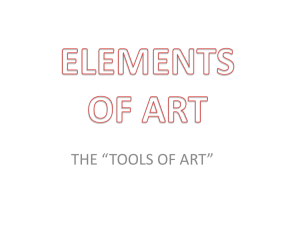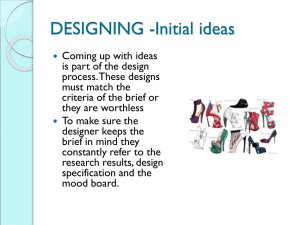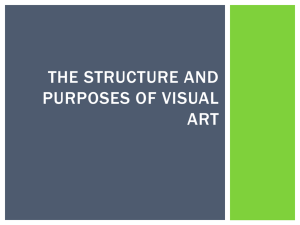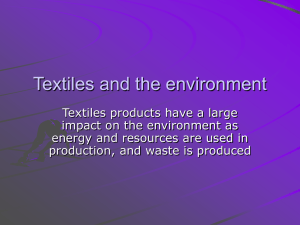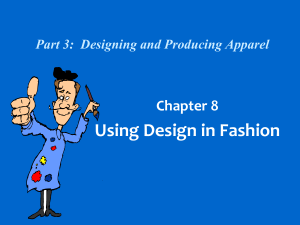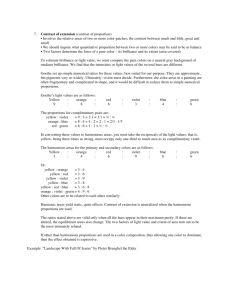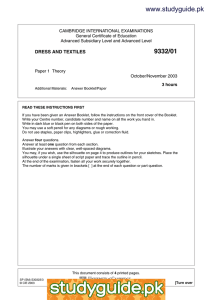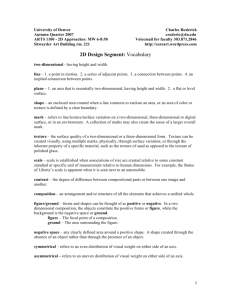Elements of Design
advertisement
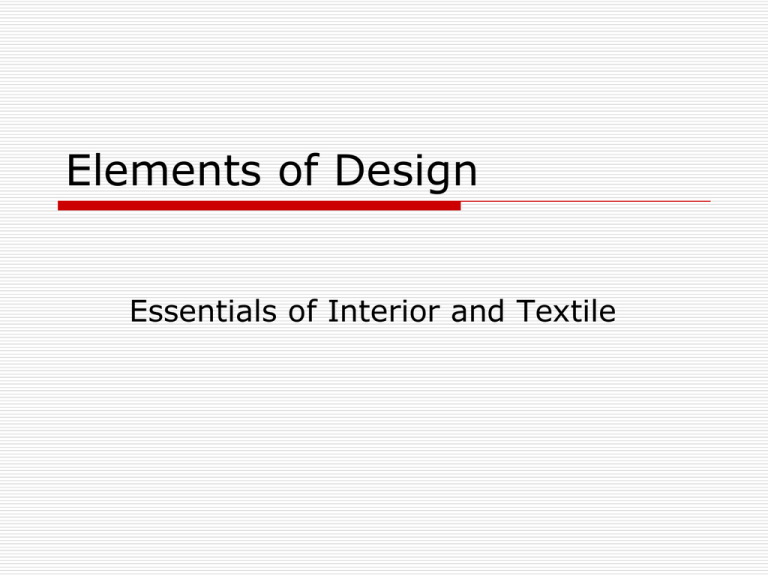
Elements of Design Essentials of Interior and Textile Color Red –positive, energetic and impulsive Orange –exciting and glowing Yellow – cheerful, creative, and intellectual Green – fresh and restful Violet – cooling Purple – soothing, richness, and royal Blue – calming, peaceful, and conservative White – innocence and purity Black – fearful and formal Brown - earthy Color Terms Primary – red, yellow, blue Secondary – orange, green, violet Intermediate (tertiary) – combination of primary and secondary Hue – a pure color Tint – adding white Shade – adding black Tone – adding gray Value – lightness and darkness Chromatic colors – adding hues of black, white and gray Color Schemes Warm hues- red, orange, and yellow Cool hues – blue, green, violet Monochromatic – scheme based on one hue (tints, tones, and value) Complementary – opposite on the color wheel Split-complementary – a hue and the 2 adjacent to the complement Analogous – 3 to 5 hues connected Triadic – equally distant on color wheel Examples in clothing and interiors Find 2 examples of each of the following color schemes Monochromatic primary Warm Cool Analogous Complementary Triadic Swatch card for your clothing line or Paint Sample Design and construct a swatch card for the incoming season, to be used by the manufacturer, pattern/paint company, magazine, retail buyer, or consumer. The swatch care should include An original theme Color sample, using colored pencils Color names (be creative) A written description of color & trends for the season Elements of Design Definition – building blocks of design; line, shape, space, texture, and color Line Series of point connected together to form a narrow path Gives feeling of direction and movement Types of straight lines Vertical –look taller, slender, feeling of strength, add height Horizontal – look shorter, wider, feeling of stability, Diagonal – add movement and excitement Curved Lines Circular or gentle waves add softness and roundness Shape and Space Shape - Silhouettes – outer shape Natural – follows body’s proportions Tubular – rectangular w/ vertical emphasis Bell – combine both vertical and horizontal line Full – more horizontal and curved Space – area inside Structured lines – sewing parts together Decorative lines – created by adding trims Texture Create illusions Soft or clingy fabrics – hug body, emphasize figure Moderately crisp or stiff – stand away from body, conceal Extra-crisp fabrics – stiff out shell, look larger Smooth fabrics – don’t create size, shape illision Nubby or bulky fabrics – add dimension, look larger Dull fabrics – absorb light, look smaller Shiny fabrics – reflect light, add size Principles of Design Artistic guidelines for using the various design elements within a garment/interior Balance, proportion, emphasis, rhythm, harmony Balance Symmetrical (Formal) – same on both side Asymmetrical (Informal)- one side different than other Proportion Size relationship of each internal space with in a garment/interior to one another and to the total look Proportion and scale to own size Emphasis Focal point Center of attention Should highlight best feature Carried out in a variety of ways Rhythm Flow of the lines, shapes, space, and texture Carry eye from one area to another Everything works together Harmony Pleasing arrangement of all the parts of a garment All elements work together
